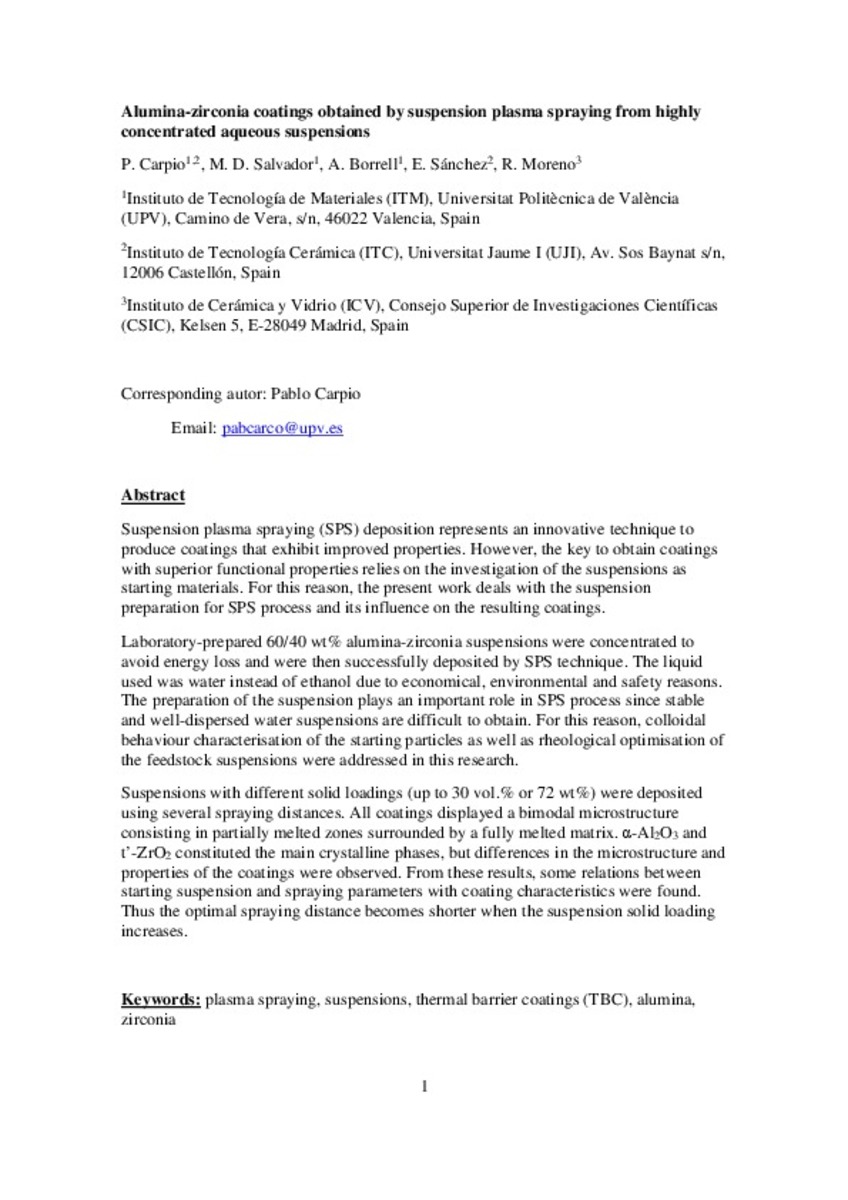Mostrar el registro sencillo del ítem
Alumina-zirconia coatings obtained by suspension plasma spraying from highly concentrated aqueous suspensions
| dc.contributor.author | Carpio Cobo, Pablo | |
| dc.contributor.author | Salvador, M. D. | |
| dc.contributor.author | Borell, A. | |
| dc.contributor.author | Sánchez-Vilches, Enrique | |
| dc.contributor.author | Moreno, R. | |
| dc.date.accessioned | 2017-01-18T16:11:17Z | |
| dc.date.available | 2017-01-18T16:11:17Z | |
| dc.date.issued | 2016 | |
| dc.identifier.citation | CARPIO, P., et al. Alumina-zirconia coatings obtained by suspension plasma spraying from highly concentrated aqueous suspensions. Surface and Coatings Technology, 2016, vol. 307, p. 713-719 | ca_CA |
| dc.identifier.issn | 0257-8972 | |
| dc.identifier.issn | 1879-3347 | |
| dc.identifier.uri | http://hdl.handle.net/10234/165397 | |
| dc.description.abstract | Suspension plasma spraying (SPS) deposition represents an innovative technique to produce coatings that exhibit improved properties. However, the key to obtain coatings with superior functional properties relies on the investigation of the suspensions as starting materials. For this reason, the present work deals with the suspension preparation for SPS process and its influence on the resulting coatings. Laboratory-prepared 60/40 wt% alumina-zirconia suspensions were concentrated to avoid energy loss and were then successfully deposited by SPS technique. The liquid used was water instead of ethanol due to economical, environmental and safety reasons. The preparation of the suspension plays an important role in SPS process since stable and well-dispersed water suspensions are difficult to obtain. For this reason, colloidal behaviour characterisation of the starting particles as well as rheological optimisation of the feedstock suspensions were addressed in this research. Suspensions with different solid loadings (up to 30 vol.% or 72 wt%) were deposited using several spraying distances. All coatings displayed a bimodal microstructure consisting in partially melted zones surrounded by a fully melted matrix. α-Al2O3 and t’-ZrO2 constituted the main crystalline phases, but differences in the microstructure and properties of the coatings were observed. From these results, some relations between starting suspension and spraying parameters with coating characteristics were found. Thus the optimal spraying distance becomes shorter when the suspension solid loading increases. | ca_CA |
| dc.description.sponsorShip | This work has been supported by the Spanish Ministry of Economy and Competitiveness, MINECO, (project MAT2015-67586-C3-R). M.D. Salvador thanks to CAPES – Programa Ciências sem Fronteiras (Brazil) for the concession of a PVE project Nº A086/2013. A. Borrell acknowledges the MINECO for her Juan de la Cierva-Incorporación contract (IJCI-2014-19839) and the Program to Support Research and Development (PAID-00-15) of the Universitat Politècnica de València. | ca_CA |
| dc.format.extent | 17 p. | ca_CA |
| dc.format.mimetype | application/pdf | ca_CA |
| dc.language.iso | eng | ca_CA |
| dc.publisher | Elsevier | ca_CA |
| dc.relation.isPartOf | Surface and Coatings Technology, 2016, vol. 307 | ca_CA |
| dc.rights | © 2016 Elsevier B.V. All rights reserved. | ca_CA |
| dc.rights.uri | http://rightsstatements.org/vocab/InC/1.0/ | * |
| dc.subject | Plasma spraying | ca_CA |
| dc.subject | Suspensions | ca_CA |
| dc.subject | Thermal barrier coatings (TBC) | ca_CA |
| dc.subject | Alumina | ca_CA |
| dc.subject | Zirconia | ca_CA |
| dc.title | Alumina-zirconia coatings obtained by suspension plasma spraying from highly concentrated aqueous suspensions | ca_CA |
| dc.type | info:eu-repo/semantics/article | ca_CA |
| dc.identifier.doi | http://dx.doi.org/10.1016/j.surfcoat.2016.09.060 | |
| dc.rights.accessRights | info:eu-repo/semantics/openAccess | ca_CA |
| dc.relation.publisherVersion | http://www.sciencedirect.com/science/article/pii/S0257897216309446 | ca_CA |
| dc.type.version | info:eu-repo/semantics/submittedVersion |
Ficheros en el ítem
Este ítem aparece en la(s) siguiente(s) colección(ones)
-
QUI_Articles [296]







